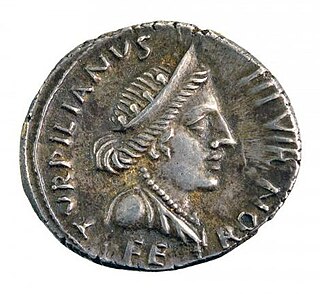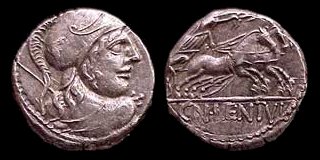Related Research Articles

In ancient Roman religion, Ceres was a goddess of agriculture, grain crops, fertility and motherly relationships. She was originally the central deity in Rome's so-called plebeian or Aventine Triad, then was paired with her daughter Proserpina in what Romans described as "the Greek rites of Ceres". Her seven-day April festival of Cerealia included the popular Ludi Ceriales. She was also honoured in the May lustration (lustratio) of the fields at the Ambarvalia festival: at harvest-time: and during Roman marriages and funeral rites. She is usually depicted as a mature woman.

Dis Pater, otherwise known as Rex Infernus or Pluto, is a Roman god of the underworld. Dis was originally associated with fertile agricultural land and mineral wealth, and since those minerals came from underground, he was later equated with the chthonic deities Pluto (Hades) and Orcus.
Libitina, also Libentina or Lubentina, is an ancient Roman goddess of funerals and burial. Her name was used as a metonymy for death, and undertakers were known as libitinarii. Libitina was associated with Venus, and the name appears in some authors as an epithet of Venus.

In ancient Roman religion, the di nixi, also Nixae, were birth deities. They were depicted kneeling or squatting, a more common birthing position in antiquity than in the modern era. The 2nd-century grammarian Festus explains their name as the participle of the Latin verb nitor, niti, nixus, "to support oneself," also "strive, labor," in this sense "be in labor, give birth." Varro said that enixae was the term for women in labor brought about by the Nixae, who oversee the types of religious practices that pertain to those giving birth. In some editions of Ovid's Metamorphoses, a phrase is taken as referring to the birth goddess Lucina and her counterpart collective, the Nixi.

Festivals in ancient Rome were a very important part in Roman religious life during both the Republican and Imperial eras, and one of the primary features of the Roman calendar. Feriae were either public (publicae) or private (privatae). State holidays were celebrated by the Roman people and received public funding. Games (ludi), such as the Ludi Apollinares, were not technically feriae, but the days on which they were celebrated were dies festi, holidays in the modern sense of days off work. Although feriae were paid for by the state, ludi were often funded by wealthy individuals. Feriae privatae were holidays celebrated in honor of private individuals or by families. This article deals only with public holidays, including rites celebrated by the state priests of Rome at temples, as well as celebrations by neighborhoods, families, and friends held simultaneously throughout Rome.

In ancient Roman religion and mythology, Tellus Mater or Terra Mater is the personification of the Earth. Although Tellus and Terra are hardly distinguishable during the Imperial era, Tellus was the name of the original earth goddess in the religious practices of the Republic or earlier. The scholar Varro (1st century BC) lists Tellus as one of the di selecti, the twenty principal gods of Rome, and one of the twelve agricultural deities. She is regularly associated with Ceres in rituals pertaining to the earth and agricultural fertility.

In Etruscan and Sabine religion, Feronia was a goddess associated with wildlife, fertility, health, and abundance, also venerated by the Faliscans and later adopted into ancient Roman religion. As the goddess who granted freedom to slaves or civil rights to the most humble part of society, she was especially honored among plebeians and freedmen. Her festival, the Feroniae, was November 13 during the Ludi Plebeii, in conjunction with Fortuna Primigenia; both were goddesses of Praeneste.
The Secular Games was a Roman religious celebration (Ludi) involving sacrifices and theatrical performances held in ancient Rome for three days and nights to mark the end of a saeculum and the beginning of the next. A saeculum, supposedly the longest possible length of human life, was considered as either 100 or 110 years in length.

The Equirria were two ancient Roman festivals of chariot racing, or perhaps horseback racing, held in honor of the god Mars, one 27 February and the other 14 March.
The Acta Arvalia were the recorded protocols of the Arval Brothers (Arvales fratres), a priestly brotherhood (sodalitas) of ancient Roman religion.

The vocabulary of ancient Roman religion was highly specialized. Its study affords important information about the religion, traditions and beliefs of the ancient Romans. This legacy is conspicuous in European cultural history in its influence on later juridical and religious vocabulary in Europe, particularly of the Christian Church. This glossary provides explanations of concepts as they were expressed in Latin pertaining to religious practices and beliefs, with links to articles on major topics such as priesthoods, forms of divination, and rituals.

The Aventine Triad is a modern term for the joint cult of the Roman deities Ceres, Liber and Libera. The cult was established ca. 493 BC within a sacred district (templum) on or near the Aventine Hill, traditionally associated with the Roman plebs. Later accounts describe the temple building and rites as "Greek" in style. Some modern historians describe the Aventine Triad as a plebeian parallel and self-conscious antithesis to the Archaic Triad of Jupiter, Mars and Quirinus and the later Capitoline Triad of Jupiter, Minerva and Juno. The Aventine Triad, temple and associated ludi served as a focus of plebeian identity, sometimes in opposition to Rome's original ruling elite, the patricians.

The Trigarium was an equestrian training ground in the northwest corner of the Campus Martius in ancient Rome. Its name was taken from the triga, a three-horse chariot.

The Taurian Games were games (ludi) held in ancient Rome in honor of the di inferi, the gods of the underworld. They were not part of a regularly scheduled religious festival on the calendar, but were held as expiatory rites religionis causa, occasioned by religious concerns.

The di inferi or dii inferi were a shadowy collective of ancient Roman deities associated with death and the underworld. The epithet inferi is also given to the mysterious Manes, a collective of ancestral spirits. The most likely origin of the word Manes is from manus or manis, meaning "good" or "kindly," which was a euphemistic way to speak of the inferi so as to avert their potential to harm or cause fear.

In ancient Roman religion, the October Horse was an animal sacrifice to Mars carried out on October 15, coinciding with the end of the agricultural and military campaigning season. The rite took place during one of three horse-racing festivals held in honor of Mars, the others being the two Equirria on February 27 and March 14.

Aprilis or mensis Aprilis (April) was the second month of the ancient Roman calendar, following Martius (March) and preceding Maius (May). On the oldest Roman calendar that had begun with March, Aprilis was the second of ten months in the year. April had 29 days on calendars of the Roman Republic, with a day added to the month during the reform in the mid-40s BC that produced the Julian calendar.
Antiquitates rerum humanarum et divinarum was one of the chief works of Marcus Terentius Varro . The work has been lost, but having been substantially quoted by Augustine in his De Civitate Dei its contents can be reconstructed in parts. To a lesser extent, quotes from the work have also been transmitted by other authors, including Pliny, Gellius, Censorinus, Servius, Nonius, Macrobius, Priscian.
References
- ↑ John H. Humphrey, Roman Circuses: Arenas for Chariot Racing (University of California Press, 1986), pp. 544, 558; Auguste Bouché-Leclercq, Manuel des Institutions Romaines (Hachette, 1886), pp. 558, 560; Marcel Le Glay, "Remarques sur la notion de Salus dans la religion romaine," La soteriologia dei culti orientali nell' imperio romano: Études préliminaires au religions orientales dans l'empire romain, Colloquio internazionale Roma, 1979 (Brill, 1982), p. 442 online.
- ↑ Robert E. A. Palmer, Studies of the Northern Campus Martius in Ancient Rome (American Philosophical Society, 1990), p. 34.
- ↑ Erich S. Gruen, "Poetry and Politics: The Beginnings of Latin Literature," in Studies in Greek Culture and Roman Policy (Brill, 1990), p. 83, note 17 online. Calvert Watkins, How to Kill a Dragon: Aspects of Indo-European Poetics (Oxford University Press, 1995), devotes a chapter to the meaning of tarentum.
- ↑ Palmer, Studies of the Northern Campus Martius, p. 20, is more skeptical than many scholars about establishing the exact location and limits of the Tarentum.
- ↑ Robert E.A. Palmer, "Silvanus, Sylvester, and the Chair of St. Peter," Proceedings of the American Philosophical Society 122 (1978), p. 239.
- ↑ Jörg Rüpke, "Communicating with the Gods," in A Companion to the Roman Republic (Wiley-Blackwell, 2007, 2010), p. 225.
- ↑ Tribus noctibus, Censorinus 17.8 (Latin). Three-night rites were also characteristic of the Gallic religious calendar, as evidenced by notations of the Gaulish word trinoχtion (equivalent to Latin trinoctium), "fête des Trois Nuits," in the Coligny calendar; Xavier Delamarre, Dictionnaire de la langue gauloise: Une approche linguistique du vieux-celtique continental (Paris: Éditions Errance, 2003, 2nd ed.), pp. 302–303.
- ↑ See Platner's entry on the Ara Ditis et Proserpina at LacusCurtius online; Livy, Periocha 49 Archived 2018-12-04 at the Wayback Machine : Ludi Diti patri ad Tarentum ex praecepto librorum facti ("games for Father Dis took place at the Tarentum, in accordance with the books," presumably the Sibylline Books).
- ↑ Humphrey, Roman Circuses, pp. 558, 577.
- ↑ H. D. Jocelyn, The Tragedies of Ennius (Cambridge University Press, 1967), p. 331, with reference to Kurt Latte, Römische Religionsgeschichte (C.H. Beck, 1967, 1992), p. 246ff.
- ↑ Censorinus 17.8; Rupke, "Communicating with the Gods," p. 225.
- ↑ Hendrik Wagenvoort, "The Origin of the Ludi Saeculares," in Studies in Roman Literature, Culture and Religion (Brill, 1956), p. 219 et passim; see also John F. Hall III, "The Saeculum Novum of Augustus and its Etruscan Antecedents," Aufstieg und Niedergang der römischen Welt II.16.3 (1986), p. 2574.
- ↑ Watkins notes (p. 348) that the Oxford Latin Dictionary omits the tarentum of Acca in the Velabrum, where based on a reconstructed passage of Varro (De lingua latina 6.23–24) the meaning "tomb" is required; Varro glosses tarentum Accas (an archaic form of the genitive singular feminine) with sepulchrum Accae.
- ↑ Watkins, How to Kill a Dragon, p. 351.